General Description
The MAX705–MAX708/MAX813L microprocessor (µP)
supervisory circuits reduce the complexity and number of
components required to monitor power-supply and battery
functions in µP systems. These devices significantly improve
system reliability and accuracy compared to separate ICs or
discrete components.
The MAX705/MAX706/MAX813L provide four functions:
1) A reset output during power-up, power-down, and
brownout conditions.
2) An independent watchdog output that goes low if
the watchdog input has not been toggled within 1.6
seconds.
3) A 1.25V threshold detector for power-fail warning, low-
battery detection, or for monitoring a power supply
other than +5V.
4) An active-low manual-reset input.
The MAX707/MAX708 are the same as the MAX705/
MAX706, except an active-high reset is substituted for
the watchdog timer. The MAX813L is the same as the
MAX705, except RESET is provided instead of RESET.
Two supply-voltage monitor levels are available: The
MAX705/MAX707/MAX813L generate a reset pulse when
the supply voltage drops below 4.65V, while the MAX706/
MAX708 generate a reset pulse below 4.40V. All four parts
are available in 8-pin DIP, SO, and µMAX® packages.
Applications
● Computers
● Controllers
● Intelligent Instruments
● Critical μP Power Monitoring
Pin Configurations appear at end of data sheet.
Benefits and Features
● Supervisory-Function Integration Significantly
Improves System Reliability While Reducing Board
Space
• μMAX Package
• Guaranteed RESET Valid at VCC = 1V
- 200ms Reset Pulse Width
- Debounced TTL/CMOS-Compatible Manual-
- Active-High Reset Output (MAX707/MAX708/
Reset Input
MAX813L)
• Precision-Supply Voltage Monitor
- 4.65V (MAX705/MAX707/MAX813L)
- 4.40V (MAX706/MAX708)
• Voltage Monitor for Power-Fail or Low-Battery
Warning
Ordering Information
PART
TEMP RANGE
0°C to +70°C
0°C to +70°C
0°C to +70°C
0°C to +70°C
PIN-PACKAGE
8 Plastic DIP
8 SO
8 μMAX
Dice*
MAX705CPA
MAX705CSA
MAX705CUA
MAX705C/D
*Dice are specified at TA = +25°C.
**Contact factory for availability and processing to MIL-STD-883.
Devices in PDIP, SO, and μMAX packages are available in both
leaded and lead(Pb)-free/RoHS-compliant packaging. Specify
lead-free by adding the + symbol at the endof the part number
when ordering.
Lead-free packaging is not available for CERDIP packages.
Ordering Information continued at end of data sheet.
Typical Operating Circuit
UNREGULATED DC
MAX667
+5V DC LINEAR
REGULATOR
VCC
PFI
RESET
PFI
WDO
PFO
MAX705
MAX706
MAX813L
µMAX is a registered trademark of Maxim Integrated Products, Inc.
MR
PUSHBUTTON
SWITCH
19-4334; Rev. 10; 4/15
µP
VCC
RESET
I/O LINE
NMI
INTERRUPT
MAX705–MAX708/MAX813LLow-Cost, μP Supervisory Circuits�
Absolute Maximum Ratings
Terminal Voltage (with respect to GND)
VCC .....................................................................-0.3V to 6.0V
All Other Inputs (Note 1) ..................... -0.3V to (VCC + 0.3V)
Input Current
VCC .................................................................................20mA
GND ...............................................................................20mA
Output Current (all outputs) ................................................20mA
Continuous Power Dissipation (TA = +70°C)
Plastic DIP (derate 9.09mW/°C above +70°C) ............727mW
SO (derate 5.88mW/°C above +70°C) ........................471mW
μMAX (derate 4.10mW/°C above +70°C) ...................330mW
Note 1: The input-voltage limits on PFI and MR can be exceeded if the input current is less than 10mA.
Stresses beyond those listed under “Absolute Maximum Ratings” may cause permanent damage to the device. These are stress ratings only, and functional operation of the device at these
or any other conditions beyond those indicated in the operational sections of the specifications is not implied. Exposure to absolute maximum rating conditions for extended periods may affect
device reliability.
CERDIP (derate 8.00mW/°C above +70°C) ................640mW
Operating Temperature Ranges
MAX70_C__, MAX813LC__ ...............................0°C to +70°C
MAX70_E__, MAX813LE__ .......................... -40°C to +85°C
MAX70_MJA ................................................. -55°C to +125°C
Storage Temperature Range ............................ -65°C to +160°C
Lead Temperature (soldering, 10s) .................................+300°C
Soldering Temperature (reflow)
Lead(Pb)-free...............................................................+260°C
Containing Lead(Pb) ....................................................+240°C
Electrical Characteristics
(VCC = 4.75V to 5.5V for MAX705/MAX707/MAX813L, VCC = 4.5V to 5.5V for MAX706/MAX708, TA = TMIN to TMAX, unless otherwise
noted.)
PARAMETER
SYMBOL
CONDITIONS
MAX70_C
MAX813LC
MAX70_E/M, MAX813LE/M
MAX705C, MAX706C, MAX813LC
MAX705E/M, MAX706E/M, MAX813LE/M
MAX707C, MAX708C
MAX707E/M, MAX708E/M
MAX705, MAX707, MAX813L
MAX706, MAX708
MIN
1.0
1.1
1.2
4.50
4.25
140
TYP
150
150
50
50
4.65
4.40
40
200
Operating Voltage Range
VCC
Supply Current
ISUPPLY
Reset Threshold (Note 2)
Reset Threshold Hysteresis (Note 2)
Reset Pulse Width (Note 2)
VRT
tRS
RESET Output Voltage
RESET Output Voltage
ISOURCE = 800μA
ISINK = 3.2mA
MAX70_C, VCC = 1V, ISINK = 50μA
MAX70_E/M, VCC = 1.2V, ISINK = 100μA
MAX707, MAX708, ISOURCE = 800μA
MAX707, MAX708, ISINK = 1.2mA
MAX813LC, ISOURCE = 4μA, VCC = 1.1V
MAX813LE/M, ISOURCE = 4μA, VCC = 1.2V
MAX813L
ISOURCE = 800μA
ISINK = 3.2mA
VCC - 1.5
VCC - 1.5
0.8
0.9
VCC - 1.5
UNITS
V
µA
V
mV
ms
V
V
MAX
5.5
5.5
5.5
350
500
350
500
4.75
4.50
280
0.4
0.3
0.3
0.4
0.4
Maxim Integrated │ 2
MAX705–MAX708/MAX813LMAX705–MAX708/MAX813L Low-Cost, μP Supervisory Circuitswww.maximintegrated.com�
Electrical Characteristics (continued)
(VCC = 4.75V to 5.5V for MAX705/MAX707/MAX813L, VCC = 4.5V to 5.5V for MAX706/MAX708, TA = TMIN to TMAX, unless otherwise
noted.)
PARAMETER
Watchdog Timeout Period
WDI Pulse Width
WDI Input Threshold
Low
High
WDI Input Current
WDO Output Voltage
MR Pull-Up Current
MR Pulse Width
MR Input Threshold
Low
High
MR to Reset Out Delay (Note 2)
PFI Input Threshold
PFI Input Current
PFO Output Voltage
SYMBOL
tWD
tWP
CONDITIONS
MAX705, MAX706, MAX813L
VIL = 0.4V, VIH = (VCC) (0.8)
MAX705, MAX706, MAX813L, VCC = 5V
MAX705, MAX706, MAX813L, VCC = 5V
MAX705, MAX706, MAX813L, WDI = 0V
MAX705, MAX706, MAX813L,
ISOURCE = 800μA
MAX705, MAX706, MAX813L,
ISINK = 1.2mA
MR = 0V
tMR
tMD
MIN
1.00
50
3.5
-150
VCC - 1.5
100
150
2.0
50
-50
250
VCC = 5V
ISOURCE = 800μA
ISINK = 3.2mA
1.25
+0.01
1.20
-25.00
VCC - 1.5
TYP
1.60
MAX
2.25
UNITS
s
ns
V
µA
V
μA
ns
V
ns
V
nA
V
0.8
150
0.4
600
0.8
250
1.30
+25.00
0.4
Note 2: Applies to both RESET in the MAX705–MAX708 and RESET in the MAX707/MAX708/MAX813L.
Maxim Integrated │ 3
MAX705–MAX708/MAX813LMAX705–MAX708/MAX813L Low-Cost, μP Supervisory Circuitswww.maximintegrated.com�
Typical Operating Characteristics
MAX705/MAX707
RESET OUTPUT VOLTAGE
vs. SUPPLY VOLTAGE
MAX705 toc01
+5V
VCC
0V
RESET
0V
TA = +25°C
2kΩ
RESET
330pF
VCC
VCC
RESET
GND
500ms/div
POWER-FAIL COMPARATOR
ASSERTION RESPONSE TIME
MAX705 toc04
+5V
PFO
PFI
+5V
PFO
1kΩ
30pF
+1.25V
VCC = +5V
TA = +25°C
+1.30V
PFI
/
1
V
d
v
i
+5V
/
1
V
d
v
i
/
1
V
d
v
i
0V
5
0
m
V
d
v
/
i
+5V
VCC
+5V
RESET
+5V
0V
+5V
+1.20V
0V
400ns/div
MAX705/MAX707
RESET RESPONSE TIME
MAX705 toc02
+4V
TA = +25°C
/
1
V
d
v
i
POWER-FAIL COMPARATOR
DE-ASSERTION RESPONSE TIME
MAX705 toc08
PFI
+5V
PFO
VCC = +5V
TA = +25°C
30pF
+1.25V
1kΩ
PFO
0V
VCC
VCC
RESET
GND
10kΩ
RESET
30pF
PFI
+1.20V
0V
2µs/div
400ns/div
MAX707
RESET, RESET ASSERTION
MAX705 toc05
MAX707
RESET, RESET DE-ASSERTION
MAX705 toc06
VCC = VRT
TA = +25°C
VCC
RESET
RESET
GND
10kΩ
10k
330pF
400ns/div
RESET
/
1
V
d
v
i
330pF
RESET
+5V
0V
+5V
0V
VCC = VRT
TA = +25°C
VCC
RESET
RESET
GND
10kΩ
10k
330pF
330pF
400ns/div
+3V
+1.30V
RESET
/
2
V
d
v
i
RESET
MAX707/MAX708/MAX813L
RESET OUTPUT VOLTAGE
vs. SUPPLY VOLTAGE
MAX705 toc07
+5V
/
1
V
d
v
i
+5V
/
1
V
d
v
i
TA = +25°C
VCC
RESET
GND
330pF 10kΩ
VCC
0V
RESET
0V
MAX813L
RESET RESPONSE TIME
MAX705 toc08
VCC
RESET
GND
330pF 10kΩ
+4V
+4V
+5V
VCC
0V
0V
500ms/div
2µs/div
Maxim Integrated │ 4
MAX705–MAX708/MAX813LMAX705–MAX708/MAX813L Low-Cost, μP Supervisory Circuitswww.maximintegrated.com�
Pin Description
PIN
MAX705/MAX706 MAX707/MAX708
μMAX
DIP/SO
DIP/SO
μMAX
MAX813L
NAME
DIP/SO
μMAX
FUNCTION
1
2
3
4
5
6
3
4
5
6
7
8
—
—
7
8
1
2
1
2
3
4
5
—
6
7
3
4
5
6
7
—
—
1
—
—
—
—
8
2
1
2
3
4
5
6
—
—
8
7
3
4
5
6
7
8
MR
VCC
GND
PFI
PFO
WDI
Manual-Reset Input triggers a reset pulse when
pulled below 0.8V. This active-low input has an
internal 250μA pullup current. It can be driven from a
TTL or CMOS logic line, as well as shorted to ground
with a switch.
+5V Supply Input
0V Ground Reference for all signals
Power-Fail Voltage-Monitor Input. When PFI is less
than 1.25V, PFO goes low. Connect PFI to GND or
VCC when not used.
Power-Fail Output goes low and sinks current when
PFI is less than 1.25V; otherwise PFO stays high.
Watchdog Input. If WDI remains high or low for
1.6sec, the internal watchdog timer runs out and
WDO goes low (Figure 1). Floating WDI or connecting
WDI to a high-impedance three-state buffer disables
the watchdog feature. The internal watchdog timer
clears whenever reset is asserted, WDI is three
stated, or WDI sees a rising or falling edge.
—
N.C.
No Connect
—
RESET
WDO
2
1
Active-Low Reset Output pulses low for 200ms when
triggered, and stays low whenever VCC is below the
reset threshold (4.65V in the MAX705 and 4.40V in
the MAX706). It remains low for 200ms after VCC
rises above the reset threshold or MR goes from low
to high (Figure 3). A watchdog timeout will not trigger
RESET unless WDO is connected to MR.
Watchdog Output pulls low when the internal
watchdog timer finishes its 1.6sec count and does
not go high again until the watchdog is cleared. WDO
also goes low during low-line conditions. Whenever
VCC is below the reset threshold, WDO stays low;
however, unlike RESET, WDO does not have a
minimum pulse width. As soon as VCC rises above
the reset threshold, WDO goes high with no delay.
RESET
Active-High RESET Output is the inverse of RESET.
Whenever RESET is high, RESET is low, and vice
versa (Figure 2). The MAX813L has a RESET output
only.
Maxim Integrated │ 5
MAX705–MAX708/MAX813LMAX705–MAX708/MAX813L Low-Cost, μP Supervisory Circuitswww.maximintegrated.com�
6
1
2
WDI
MR
VCC
4
PFI
WATCHDOG
TRANSITION
DETECTOR
VCC
250µA
4.65V*
1.25V
WATCHDOG
TIMER
TIMEBASE FOR
RESET AND
WATCHDOG
RESET
GENERATOR
MAX705
MAX706
MAX813L
8
WDO
7
RESET
(RESET)
5
PFO
1
2
4
MR
VCC
PFI
VCC
250µA
4.65V*
1.25V
RESET
GENERATOR
MAX707
MAX708
8
7
RESET
RESET
5
PFO
* 4.40V FOR MAX7O6.
( ) ARE FOR MAX813L ONLY.
3
GND
* 4.40V FOR MAX7O6.
3
GND
Figure 1. MAX705/MAX706/MAX813L Block Diagram
Figure 2. MAX707/MAX708 Block Diagram
Detailed Description
Reset Output
A microprocessor’s (μP’s) reset input starts the μP in a
known state. Whenever the μP is in an unknown state, it
should be held in reset. The MAX705–MAX708/MAX813L
assert reset during power-up and prevent code execution
errors during power-down or brownout conditions.
On power-up, once VCC reaches 1V, RESET is a
guaranteed logic low of 0.4V or less. As VCC rises, RESET
stays low. When VCC rises above the reset threshold, an
internal timer releases RESET after about 200ms. RESET
pulses low whenever VCC dips below the reset threshold,
i.e. brownout condition. If brownout occurs in the middle
of a previously initiated reset pulse, the pulse continues
for at least another 140ms. On power-down, once VCC
falls below the reset threshold, RESET stays low and is
guaranteed to be 0.4V or less until VCC drops below 1V.
The MAX707/MAX708/MAX813L active-high RESET
output is simply the complement of the RESET output,
and is guaranteed to be valid with VCC down to 1.1V.
Some μPs, such as Intel’s 80C51, require an active-high
reset pulse.
Watchdog Timer
The MAX705/MAX706/MAX813L watchdog
circuit
monitors the μP’s activity. If the μP does not toggle the
watchdog input (WDI) within 1.6sec and WDI is not three
stated, WDO goes low. As long as RESET is asserted or
the WDI input is three stated, the watchdog timer stays
cleared and will not count. As soon as reset is released
and WDI is driven high or low, the timer starts counting.
Pulses as short as 50ns can be detected.
Typically, WDO is not connected to the nonmaskable
interrupt input (NMI) of a μP. When VCC drops below
the reset threshold, WDO goes low whether or not
the watchdog timer has timed out yet. Normally this
would trigger an NMI interrupt, but RESET goes low
simultaneously, and thus overrides the NMI interrupt.
If WDI is left unconnected, WDO can be used as a low-
line output. Since floating WDI disables the internal timer,
WDO goes low only when VCC falls below the reset
threshold, thus functioning as a low-line output.
The MAX705/MAX706 have a watchdog timer and a
RESET output. The MAX707/MAX708 have both active-
high and active-low reset outputs. The MAX813L has both
an active-high reset output and a watchdog timer.
Manual Reset
The manual-reset input (MR) allows reset to be triggered
by a pushbutton switch. The switch
is effectively
debounced by the 140ms minimum reset pulse width. MR
is TTL/CMOS-logic compatible, so it can be driven by an
external logic line. MR can be used to force a watchdog
timeout to generate a reset pulse in the MAX705/ MAX706/
MAX813L. Simply connect WDO to MR.
Maxim Integrated │ 6
MAX705–MAX708/MAX813LMAX705–MAX708/MAX813L Low-Cost, μP Supervisory Circuitswww.maximintegrated.com�
Power-Fail Comparator
The power-fail comparator can be used for various
purposes because its output and noninverting input are
not internally connected. The inverting input is internally
connected to a 1.25V reference.
tWP
tWD
tWD
tWD
WDI
WDO
RESET
(RESET)
+5V
0V
+5V
0V
+5V
0V
+5V
0V
RESET EXTERNALLY
TRIGGERED BY MR
tRS
( ) ARE FOR MAX813L ONLY.
Figure 3. MAX705/MAX706/MAX813L Watchdog Timing
VCC
+5V
RESET
0V
+5V
0V
+5V
0V
MR
WDO
VRT
VRT
tRS
tRS
tMD
tMR
MR EXTERNALLY DRIVEN LOW
Figure 4. MAX705/MAX706 RESET, MR, and WDO Timing with
WDI Three Stated. The MAX707/MAX708/MAX813L RESET
output is the inverse of RESET shown.
To build an early-warning circuit for power failure, connect
the PFI pin to a voltage divider (see Typical Operating
Circuit). Choose the voltage divider ratio so that the
voltage at PFI falls below 1.25V just before the +5V
regulator drops out. Use PFO to interrupt the μP so it can
prepare for an orderly power-down.
Applications Information
Ensuring a Valid RESET Output Down to
VCC = 0V
When VCC falls below 1V, the MAX705–MAX708 RESET
output no longer sinks current—it becomes an open
circuit. High-impedance CMOS logic inputs can drift
to undetermined voltages if left undriven. If a pulldown
resistor is added to the RESET pin, as shown in Figure
5, any stray charge or leakage currents will be drained
to ground, holding RESET low. Resistor value (R1) is not
critical. It should be about 100kΩ, large enough not to load
RESET and small enough to pull RESET to ground.
Monitoring Voltages Other Than the
Unregulated DC Input
Monitor voltages other than the unregulated DC by
connecting a voltage-divider to PFI and adjusting the ratio
appropriately. If required, add hysteresis by connecting a
resistor (with a value approximately 10 times the sum of
the two resistors in the potential divider network) between
PFI and PFO. A capacitor between PFI and GND reduces
the power-fail circuit’s sensitivity to high-frequency noise
on the line being monitored. RESET can be asserted on
other voltages in addition to the +5V VCC line. Connect
PFO to MR to initiate a RESET pulse when PFI drops
below 1.25V. Figure 6 shows the MAX705–MAX708
configured to assert RESET when the +5V supply falls
below the reset threshold, or when the +12V supply falls
below approximately 11V.
Monitoring a Negative Voltage
The power-fail comparator can also monitor a negative
supply rail (Figure 7). When the negative rail is good (a
negative voltage of large magnitude), PFO is low, and
when the negative rail is degraded (a negative voltage of
lesser magnitude), PFO is high. By adding the resistors
and transistor as shown, a high PFO triggers a reset.
As long as PFO remains high, the MAX705–MAX708/
MAX813L keep reset asserted (RESET = low, RESET =
high). Note that this circuit’s accuracy depends on the PFI
threshold tolerance, the VCC line, and the resistors.
Maxim Integrated │ 7
MAX705–MAX708/MAX813LMAX705–MAX708/MAX813L Low-Cost, μP Supervisory Circuitswww.maximintegrated.com�
MAX70_
RESET
R1
+12V
+5V
1MΩ
1%
130kΩ
1%
PARAMETER
+12V Reset
Threshold at +25°C
VCC
RESET
TO µP
MAX70_
MR
PFO
PFI
GND
MIN TYP MAX UNIT
10.67
10.87
11.50
V
Figure 5. RESET Valid to Ground Circuit
Figure 6. Monitoring Both +5V and +12V
VCC
MR
100kΩ
MAX70_
100kΩ
PFO
2N3904
PFI
RESET
GND
TO µP
+5V
R1
R2
V-
MR
PFO
+5V
0V
+5V
0V
V-
VTRIP
0V
5 1.25
–
R1
=
1.25 VTRIP
–
R2
<
, VTRIP 0
Figure 7. Monitoring a Negative Voltage
BUFFERED RESET TO OTHER SYSTEM COMPONENTS
VCC
MAX70_
RESET
GND
4.7kΩ
VCC
µP
RESET
GND
Figure 6. Monitoring Both +5V and +12V
Interfacing to μPs with
Bidirectional Reset Pins
μPs with bidirectional reset pins, such as the Motorola
68HC11 series, can contend with the MAX705–MAX708
RESET output. If, for example, the RESET output is
driven high and the μP wants to pull it low, indeterminate
logic levels may result. To correct this, connect a 4.7kΩ
resistor between the RESET output and the μP reset I/O,
as in Figure 8. Buffer the RESET output to other system
components.
Maxim Integrated │ 8
MAX705–MAX708/MAX813LMAX705–MAX708/MAX813L Low-Cost, μP Supervisory Circuitswww.maximintegrated.com�
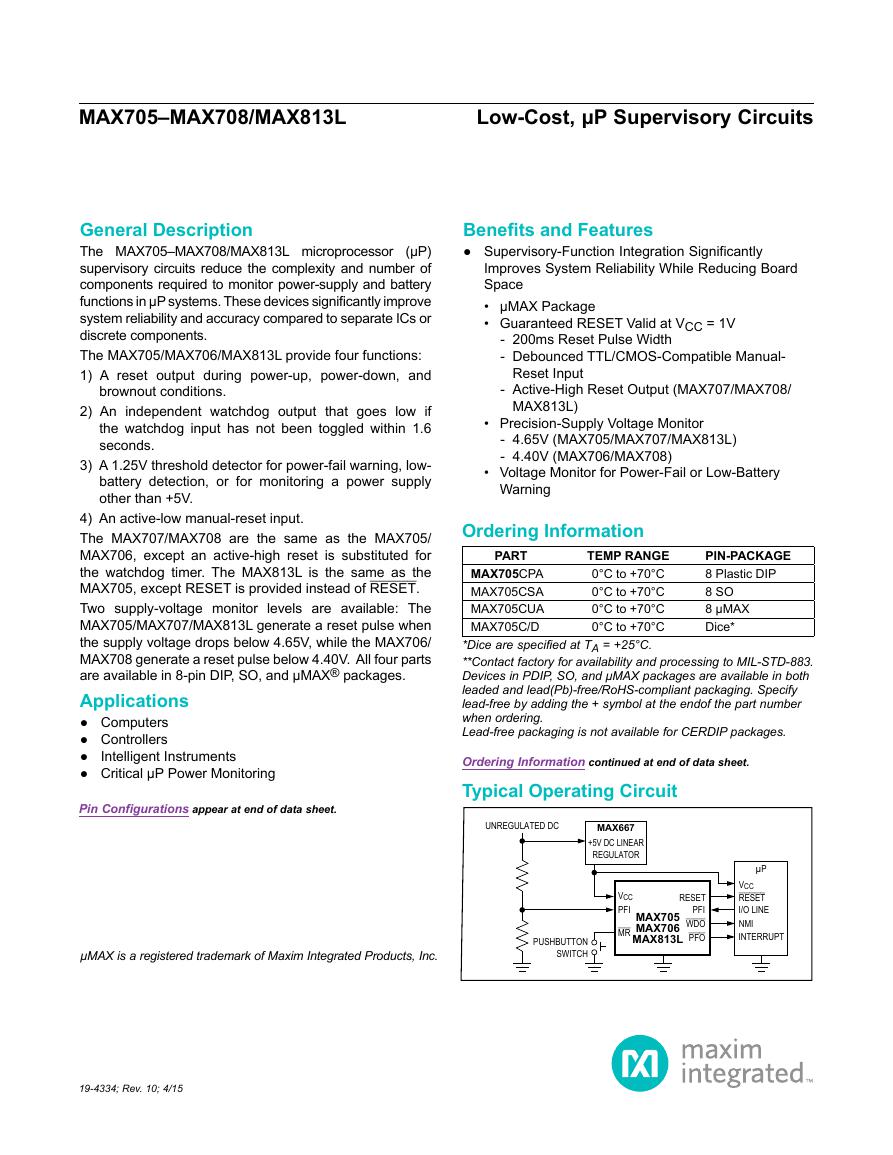
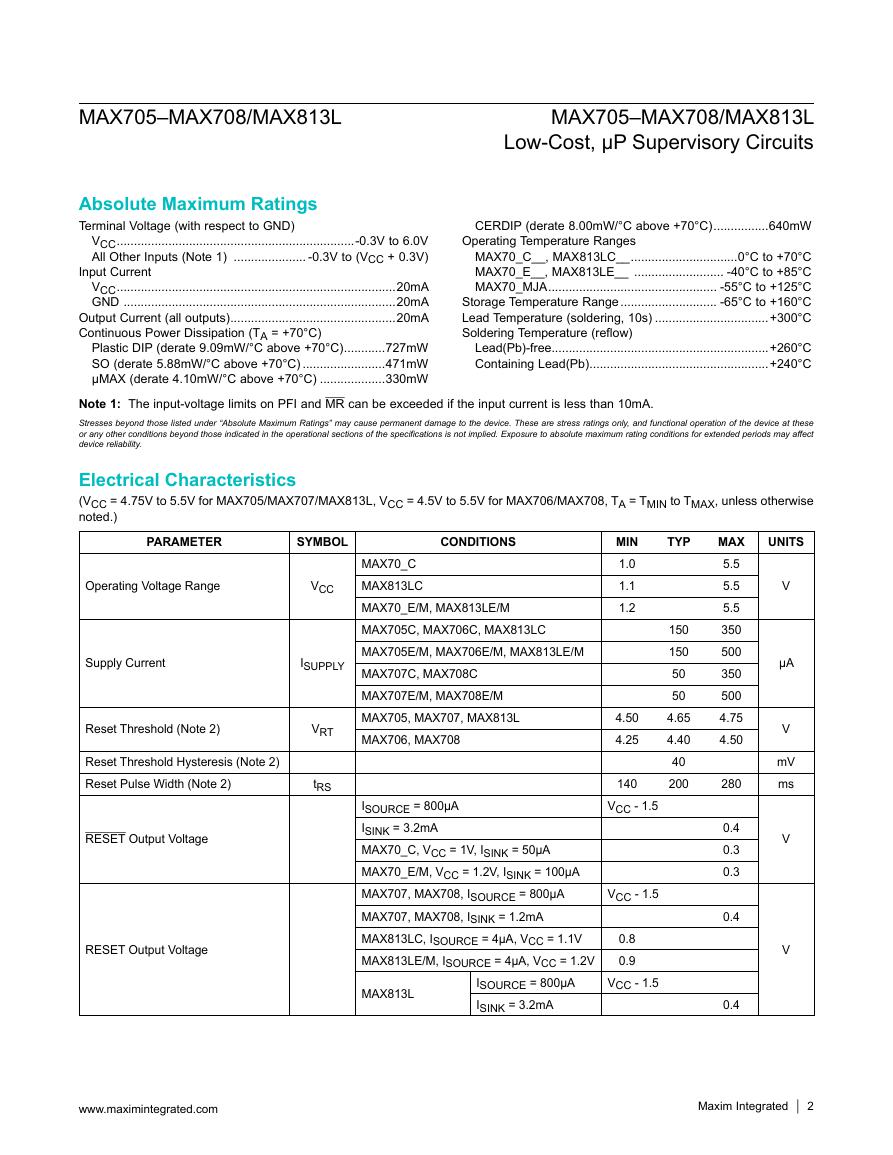
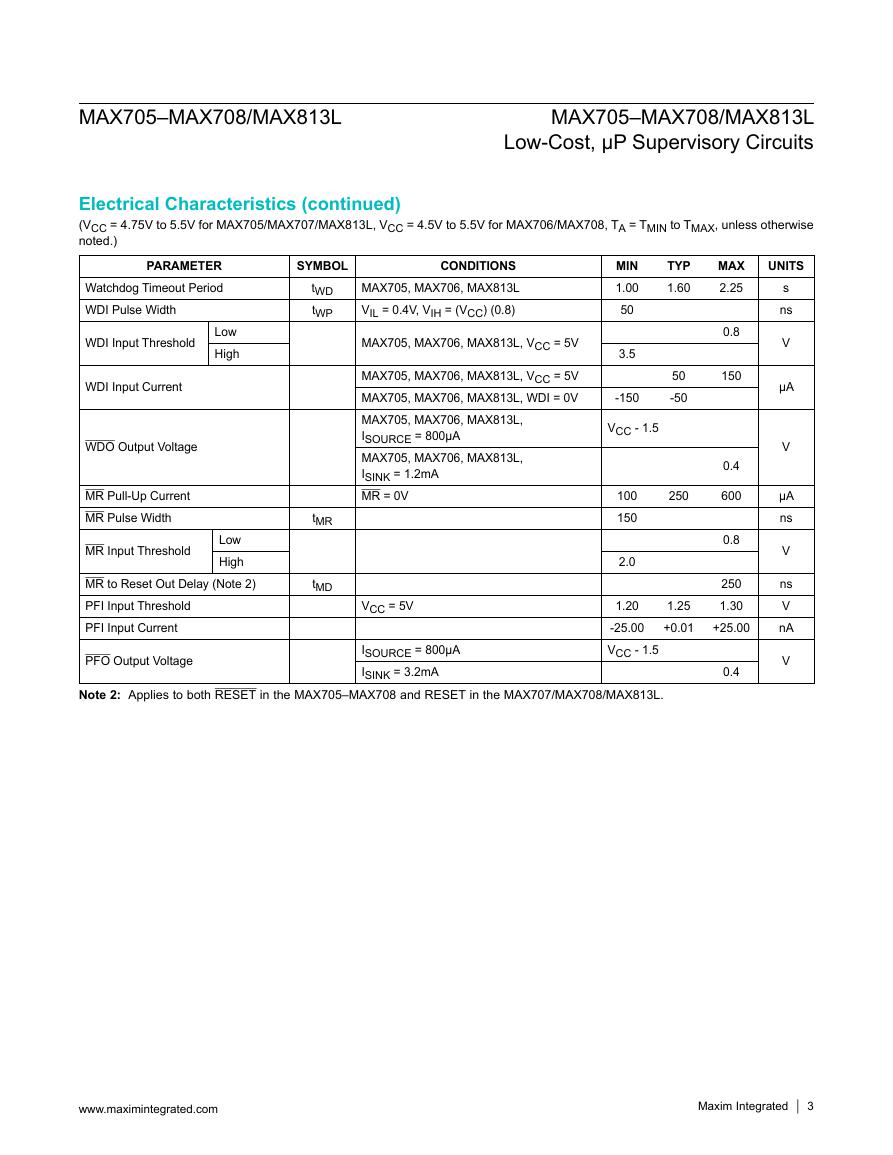
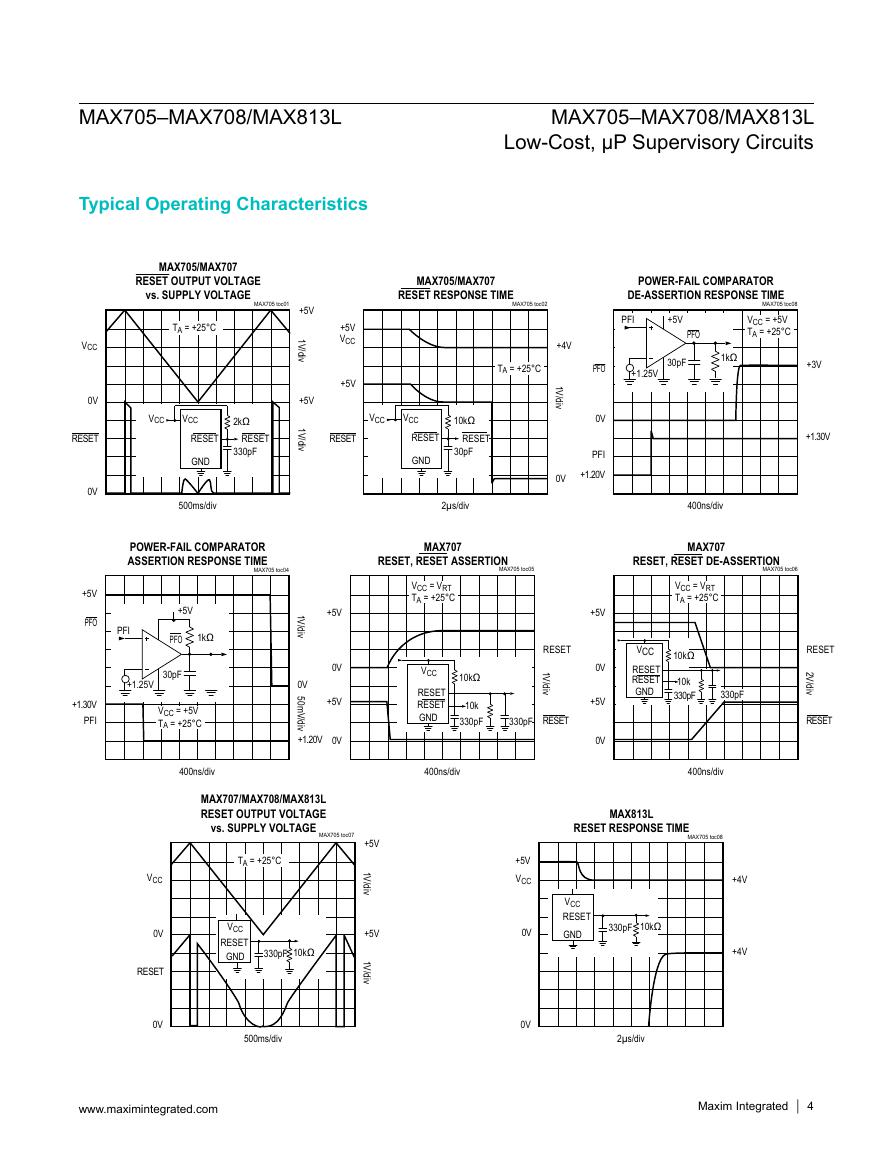
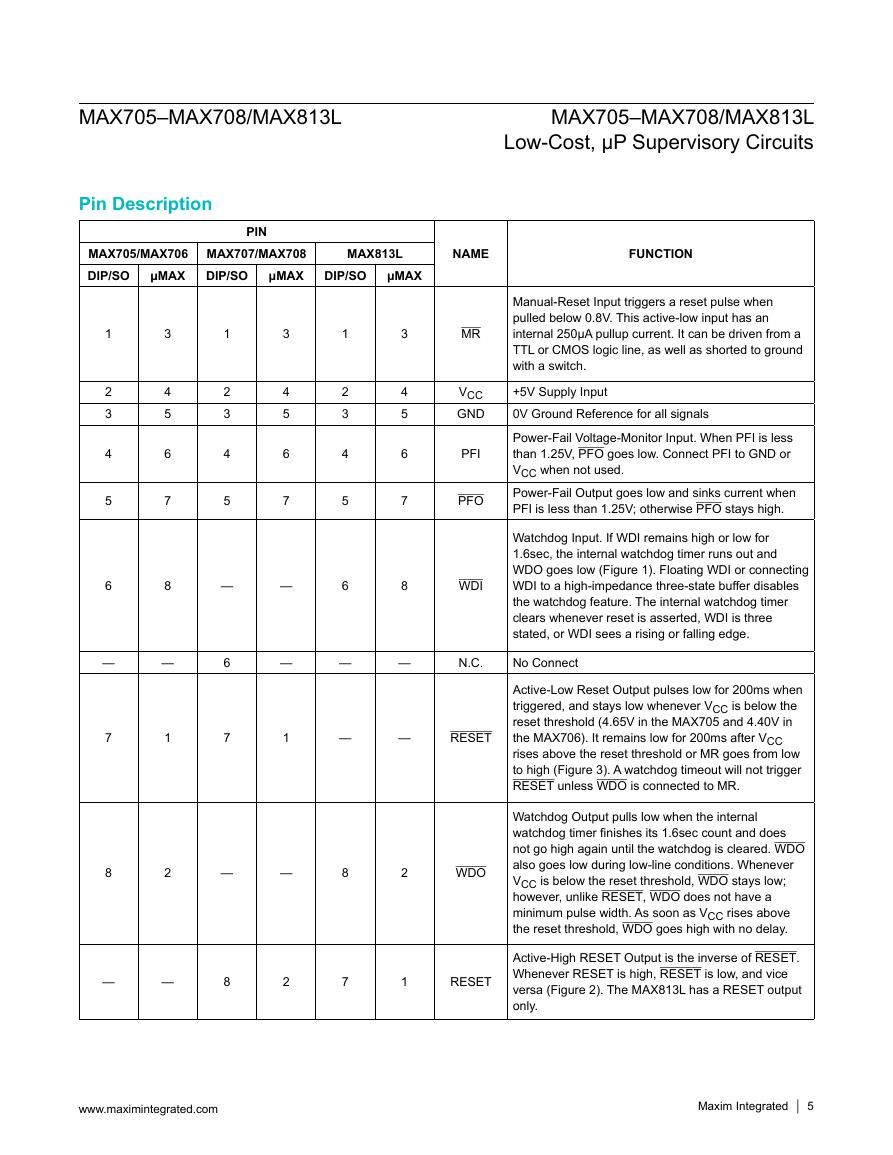
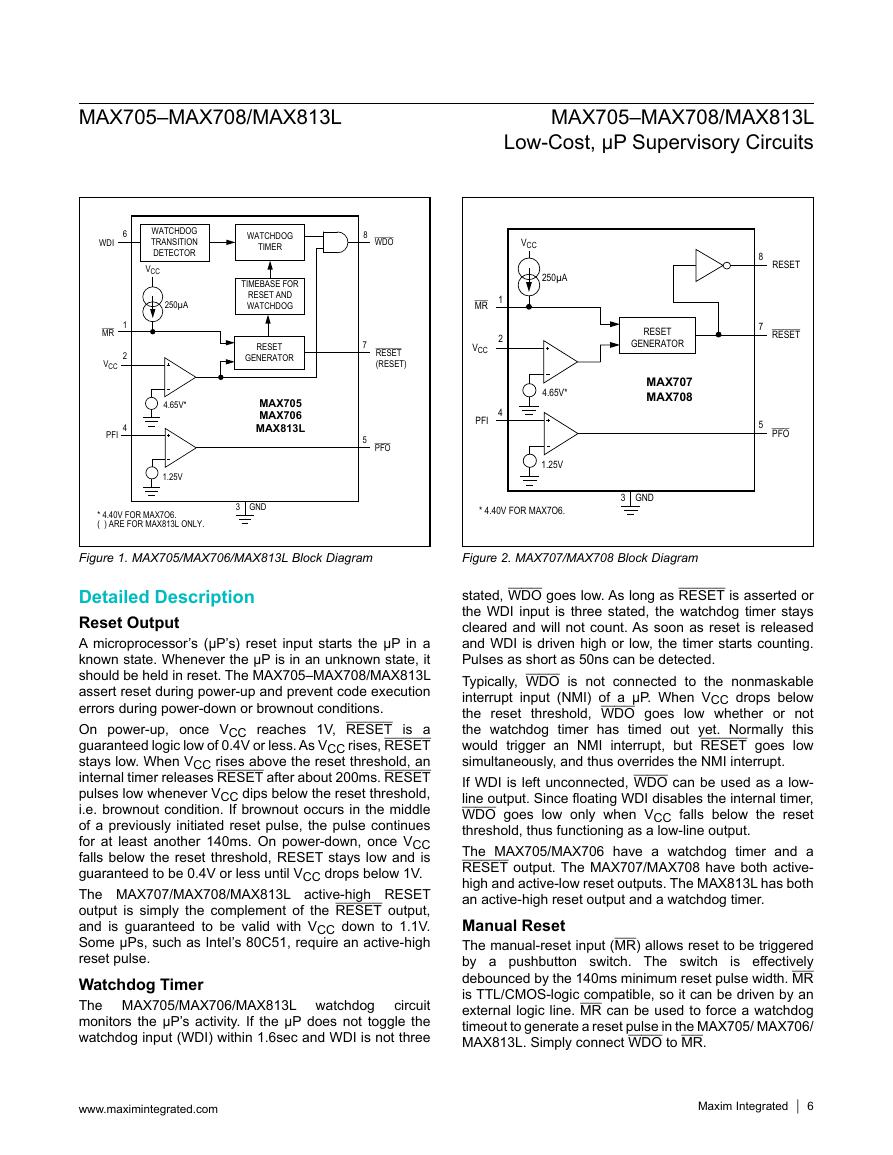
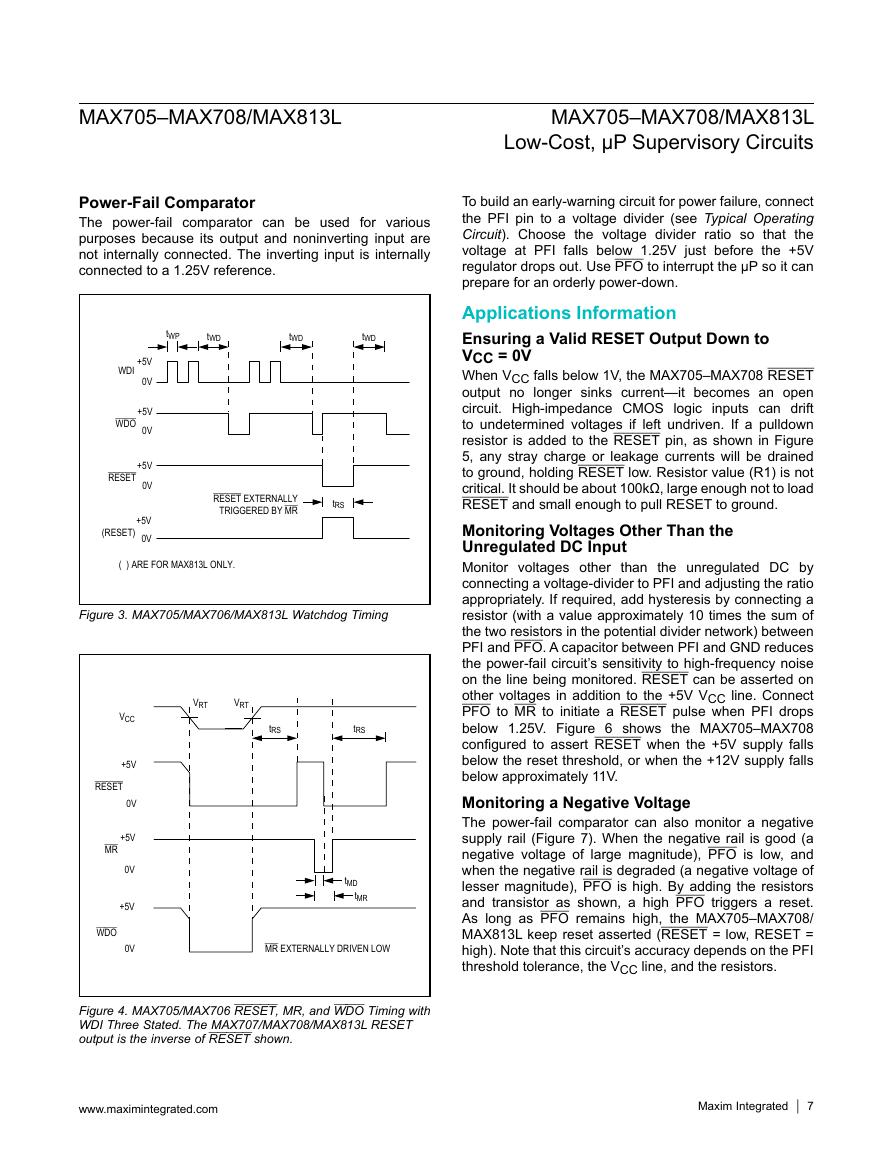









 V2版本原理图(Capacitive-Fingerprint-Reader-Schematic_V2).pdf
V2版本原理图(Capacitive-Fingerprint-Reader-Schematic_V2).pdf 摄像头工作原理.doc
摄像头工作原理.doc VL53L0X简要说明(En.FLVL53L00216).pdf
VL53L0X简要说明(En.FLVL53L00216).pdf 原理图(DVK720-Schematic).pdf
原理图(DVK720-Schematic).pdf 原理图(Pico-Clock-Green-Schdoc).pdf
原理图(Pico-Clock-Green-Schdoc).pdf 原理图(RS485-CAN-HAT-B-schematic).pdf
原理图(RS485-CAN-HAT-B-schematic).pdf File:SIM7500_SIM7600_SIM7800 Series_SSL_Application Note_V2.00.pdf
File:SIM7500_SIM7600_SIM7800 Series_SSL_Application Note_V2.00.pdf ADS1263(Ads1262).pdf
ADS1263(Ads1262).pdf 原理图(Open429Z-D-Schematic).pdf
原理图(Open429Z-D-Schematic).pdf 用户手册(Capacitive_Fingerprint_Reader_User_Manual_CN).pdf
用户手册(Capacitive_Fingerprint_Reader_User_Manual_CN).pdf CY7C68013A(英文版)(CY7C68013A).pdf
CY7C68013A(英文版)(CY7C68013A).pdf TechnicalReference_Dem.pdf
TechnicalReference_Dem.pdf